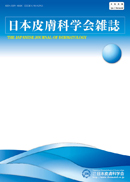All issues

Volume 119, Issue 2
Displaying 1-8 of 8 articles from this issue
- |<
- <
- 1
- >
- >|
Seminar for Medical Education
-
[in Japanese]Article type: Seminar for Medical Education
2009Volume 119Issue 2 Pages 151-156
Published: February 20, 2009
Released on J-STAGE: November 28, 2014
JOURNAL RESTRICTED ACCESS -
[in Japanese]Article type: Seminar for Medical Education
2009Volume 119Issue 2 Pages 157-161
Published: February 20, 2009
Released on J-STAGE: November 28, 2014
JOURNAL RESTRICTED ACCESS -
[in Japanese]Article type: Seminar for Medical Education
2009Volume 119Issue 2 Pages 163-171
Published: February 20, 2009
Released on J-STAGE: November 28, 2014
JOURNAL RESTRICTED ACCESS
Original Articles
-
Keigo Ito, Shin-ichi Ansai, Tetsunori KimuraArticle type: Original Articles
2009Volume 119Issue 2 Pages 173-182
Published: February 20, 2009
Released on J-STAGE: November 28, 2014
JOURNAL RESTRICTED ACCESSWe examined 421 cases of poroid cell neoplasms. These neoplasms may show nuclear atypia and mitotic figures focally; we have called such lesions bowenoid changes, and we observed 46 cases (10.9%) with these changes. These are interpreted as benign histological findings, but we consider it a possibility that these tuncrs can develop into porocarcinoma when they are present at the periphery of the tumor. We identified 143 cases (34.0%) with necrosis en masse, 368 cases (87.4%) with nuclear grooves like coffee beans, and 236 cases (56.1%) with intranuclear vacuoles. Pale cells were present in 126 cases (29.9%) and we think that these are poroid cells with clear cytoplasm. There were 119 cases (28.3%) with pseudohorn cysts. We think that these pseudohorn cysts in the poroid cell neoplasms are formed by proliferations of tumor cells in the appendage epithelium. Poroid cell neoplasms sometimes have melanin pigment and pseudohorn cysts, so these are not definite clues for differentiation these neoplasms from seborrheic keratosis. We propose that necrosis en masse, nuclear findings, and stromal changes are clues to poroid cell neoplasms.View full abstractDownload PDF (1619K) -
Tomoo FukudaArticle type: Original Articles
2009Volume 119Issue 2 Pages 183-188
Published: February 20, 2009
Released on J-STAGE: November 28, 2014
JOURNAL RESTRICTED ACCESSA glomus tumor is well known as a painful subungual tumor of the finger. It is well-circumscribed and surrounded by a fibrous capsule. Because of these characteristics, I have treated subungual glomus tumors using a simple surgical technique with two dermatological trepans. After infiltration with local anesthetics, the nail plate just above the tumor is partially avulsed using a dermatological trepan. Then another trepan is prepared and turned to cut into the cylindrical space. Finally, the bottom of the tumor is cut with scissors. I describe representative cases using this simple surgical technique. There were almost no postoperative nail deformities. This method is popular with patients. I provide here in a detailed description of the surgical procedures employed.View full abstractDownload PDF (1157K) -
Yoko Ide, Akane Minagawa, Hiroshi Koga, Yukiko Kiniwa, Shigeo Kawachi, ...Article type: Original Articles
2009Volume 119Issue 2 Pages 189-195
Published: February 20, 2009
Released on J-STAGE: November 28, 2014
JOURNAL RESTRICTED ACCESSA 67-year-old carpenter had suffered from lichenificated skin lesions on the face, neck, and back of the hands for more than 12 years. He was diagnosed with chronic actinic dermatitis at a nearby hospital, and advised to avoid sunlight. He was treated with oral antihistamine and topical steroid. He was also hospitalized for a few days, and his dermatitis cleared with a topical steroid and zinc oxide ointment with occlusive dressing technique. Once he returned to the work, he immediately had a recurrence of acute dermatitis on the same areas. He was referred to our hospital in 2006. We checked his photosensitivity and obtained normal results. We hypotlesized that he was probably exposed to some irritants or antigens. He was patch tested with the European standard series, Japanese standard series, and sawdust from pine. Rosin and sawdust from pine were positive on day 2 and day 3. We advised him to avoid exposing his skin to sawdust, and treated him with a topical steroid. After 7 months, the lichenificated skin lesions completely disappeared.View full abstractDownload PDF (1138K) -
Ai Kuraoka, Toshihumi Yamaoka, Motoi Takenaka, Shinichi Sato, Katsutar ...Article type: Original Articles
2009Volume 119Issue 2 Pages 197-203
Published: February 20, 2009
Released on J-STAGE: November 28, 2014
JOURNAL RESTRICTED ACCESSA 52-year-old man injured his left arm in a traffic accident 20 years previously and the wound had been sutured. Three years before the consultation at our clinic, the lesion swelled. A MRI revealed subcutaneous abscesses, and he was treated with surgical excision. Several months later, because of frequent exacerbation of the nodules and abscesses on the same lesion, multiple surgical resections were performed. No favorable clinical response was observed in combination with oral administrations of several antibacterial and antifungal agents. He visited our clinic for further investigation on May 10, 2007. There were some tumors and abscesses that were 2 cm in diameter, with fistulas on the previous scars. Grains in the abscess and granulomas were observed in the skin biopsy specimen. Nocardia transvalensis was isolated from the culture of the sample. No other underlying disease was detected by brain and pulmonary CT. The patient was diagnosed with mycetoma/primary cutaneous nocardiosis. He was successfully treated with oral and intravenous administration of minocycline hydrochloride, topical sulfadiazine silver, and thermotherapy.View full abstractDownload PDF (1238K)
Abstracts
-
2009Volume 119Issue 2 Pages 205-224
Published: 2009
Released on J-STAGE: November 28, 2014
JOURNAL RESTRICTED ACCESSDownload PDF (3595K)
- |<
- <
- 1
- >
- >|